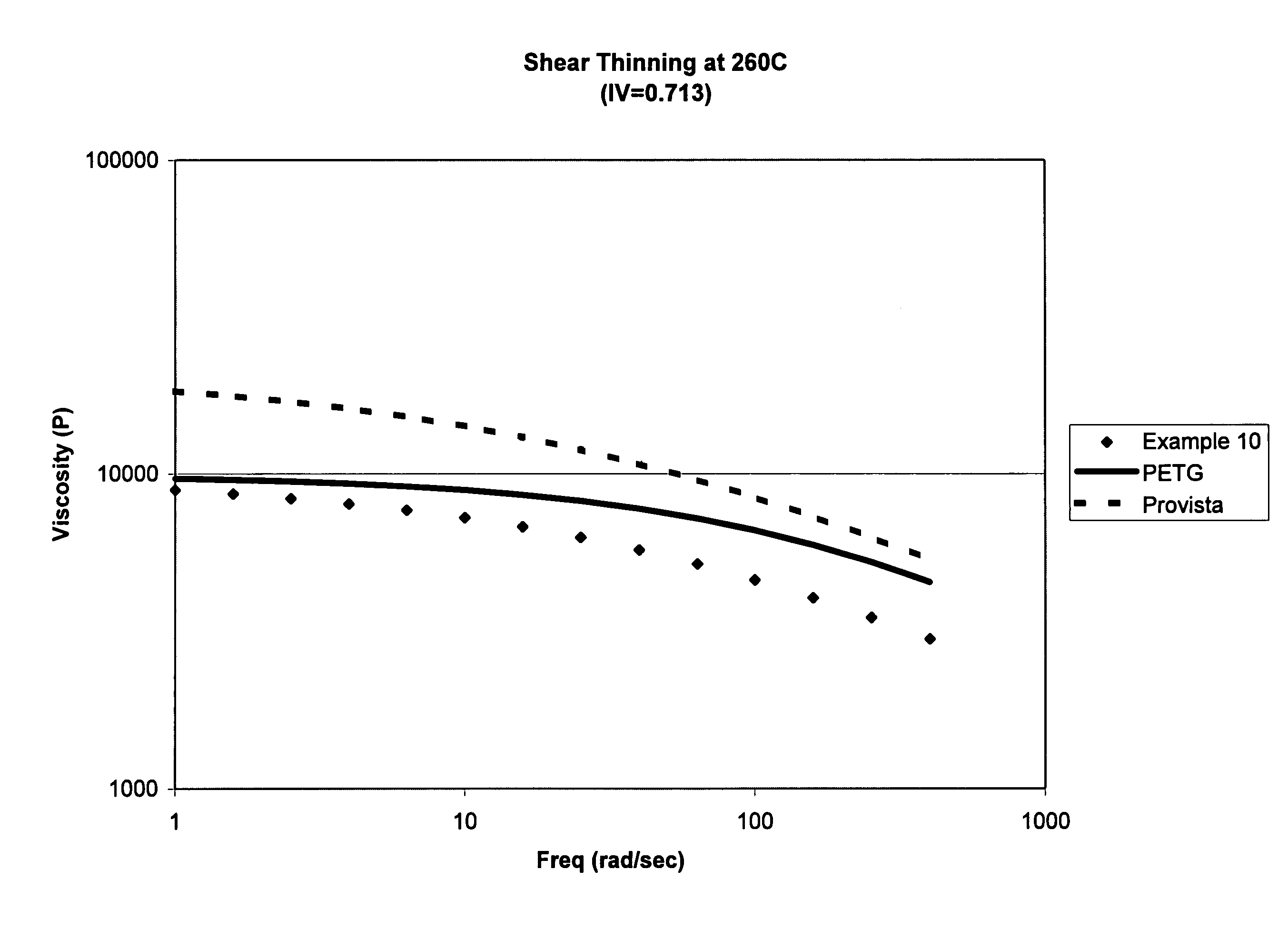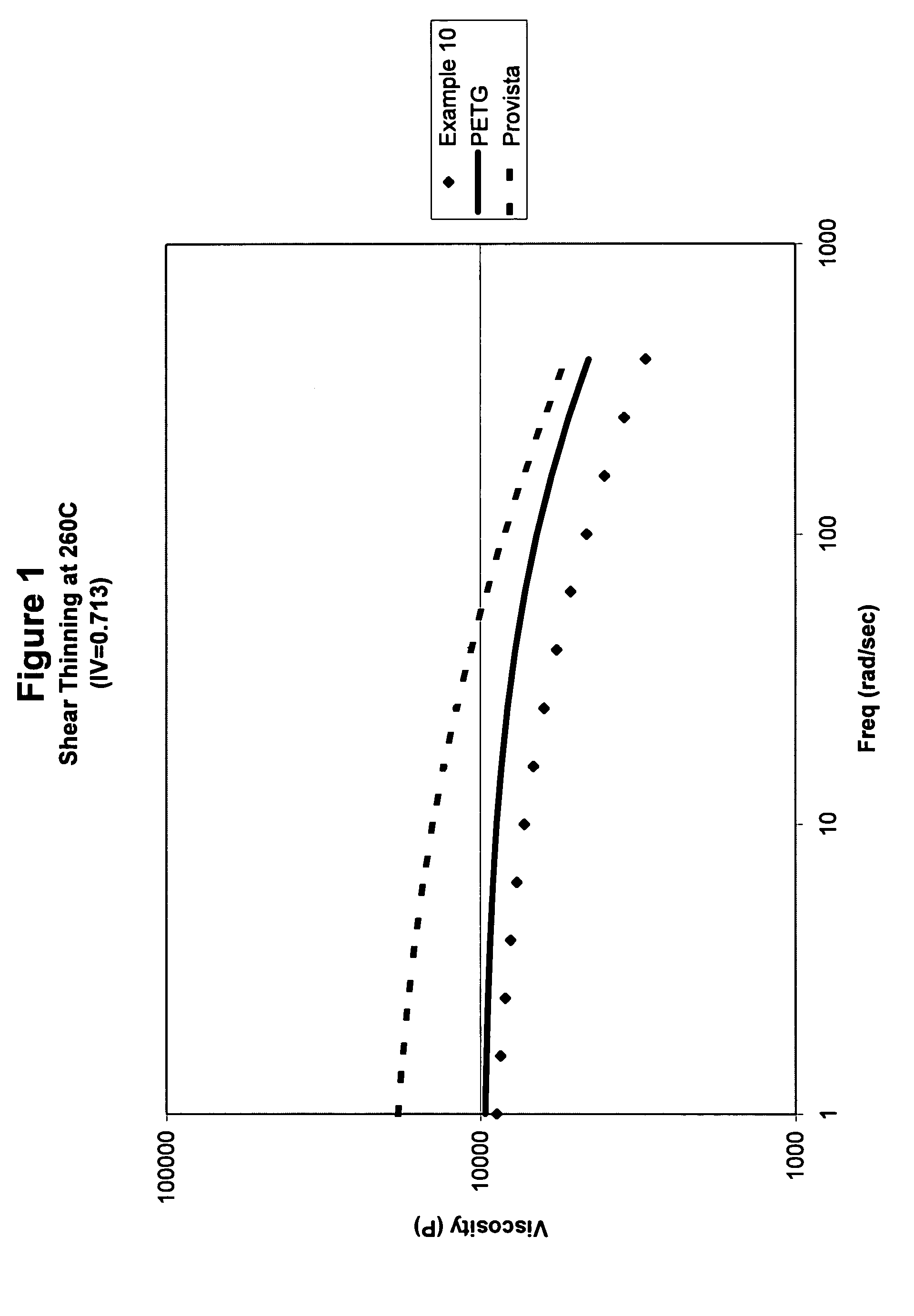Amorphous copolyesters
a copolyester and polymer technology, applied in the field of amorphous copolyesters, can solve the problems of low molecular weight polyesters disclosed by u.s. pat. no. 4,551,403 and the inability to produce shaped articles by injection molding or extrusion procedures
- Summary
- Abstract
- Description
- Claims
- Application Information
AI Technical Summary
Benefits of technology
Problems solved by technology
Method used
Image
Examples
example 1
[0038]A copolyester comprising a diacid component consisting of 100 mole percent terephthalic acid residues and a diol component consisting of 66 mole percent CHDM residues and 34 mole percent NPG residues (hereinafter referenced as 100T / 85CHDM / 15NPG) was prepared. Dimethyl terephthalate (DMT; 77.6 g, 0.4 mole), NPG (28.91 g, 0.28 moles), CHDM (46.37 g, 0.32 moles), and 1.49 ml of a solution containing 15 g of titanium tetraisopropoxide in 250 ml of n-butanol were added to a 500 ml single-neck, round-bottom flask. The flask was immersed in a Belmont metal bath that was pre-heated to 200° C. Immediately after the flask was immersed the temperature set point was increased to 220° C., and held for 1 hour. After the hour at 220° C. the temperature was increased to 260° C., and held for 30 minutes. After this time the theoretical amount of methanol was collected. The pressure in the flask then was reduced from atmospheric to 0.5 Torr. When the pressure had been reduced to 0.5 Torr the te...
example 2
[0039]A copolyester having the composition 100T / 61CHDM / 39NPG was prepared. DMT (77.60 g, 0.40 moles), NPG 33.70 grams (0.33 moles) of NPG, 39.74 grams (0.28 moles) of CHDM, and 1.49 ml of a solution containing 15 grams of titanium tetraisopropoxide in 250 ml of n-butanol were added to a 500 ml single neck round bottom flask and reacted and polymerized according to the procedure described in Example 1. The inherent viscosity of the polymer was 0.930 dL / g. The polymer had a 2nd cycle Tg of 86.70° C. with no crystalline melting point observed, and compositional analysis showed that the diol component of the copolyester consisted of 61.4 mole percent CHDM residues and 38.6 mole percent NPG residues.
example 3
[0040]A copolyester having the composition 100T / 56CHDM / 44NPG was prepared. DMT (77.6 g, 0.40 moles), NPG (38.48 g, 0.37 moles), CHDM (33.12 g, 0.23 moles), and 1.47 ml of a solution containing 15 g of titanium tetraisopropoxide in 250 ml of n-butanol were added to a 500 ml, single-neck, round-bottom flask and reacted and polymerized according to the procedure described in Example 1. The inherent viscosity of the polymer was 0.938 dL / g. The polymer had a 2nd cycle Tg of 85.90° C. with no crystalline melting point observed, and compositional analysis showed that the diol component of the copolyester consisted of 55.8 mole percent CHDM and 44.2 mole percent NPG residues.
PUM
| Property | Measurement | Unit |
|---|---|---|
| concentration | aaaaa | aaaaa |
| temperature | aaaaa | aaaaa |
| crystalline melting point | aaaaa | aaaaa |
Abstract
Description
Claims
Application Information
 Login to View More
Login to View More - R&D
- Intellectual Property
- Life Sciences
- Materials
- Tech Scout
- Unparalleled Data Quality
- Higher Quality Content
- 60% Fewer Hallucinations
Browse by: Latest US Patents, China's latest patents, Technical Efficacy Thesaurus, Application Domain, Technology Topic, Popular Technical Reports.
© 2025 PatSnap. All rights reserved.Legal|Privacy policy|Modern Slavery Act Transparency Statement|Sitemap|About US| Contact US: help@patsnap.com



